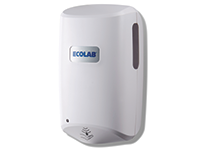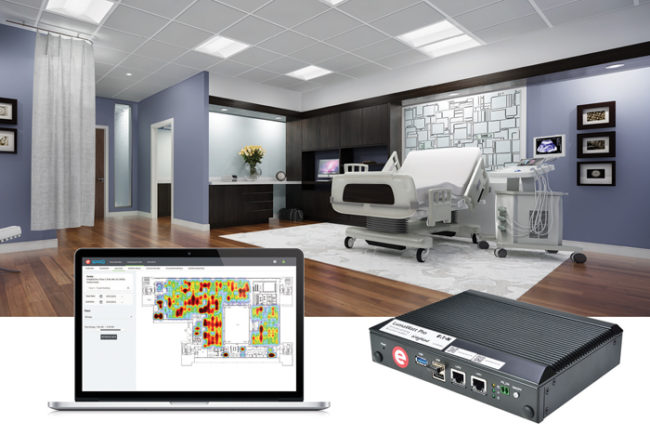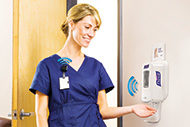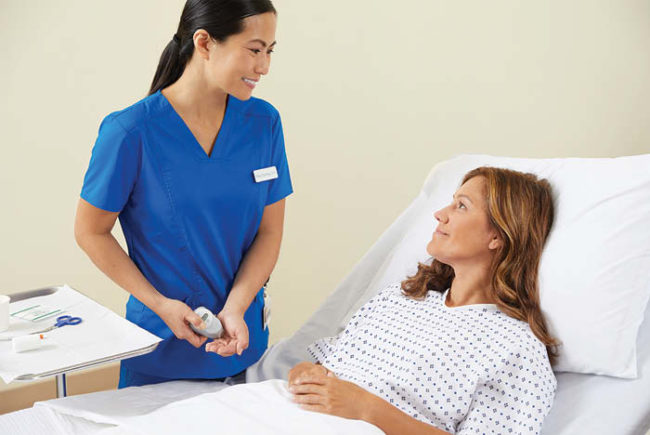A wide range of hand-hygiene compliance monitoring systems are available to help facilities managers decrease the growing number of health care-associated infections (HAIs). These systems are designed to monitor the patient care environment, remind personnel of critical hand-washing events and provide data to drive improved compliance. While the market penetration is relatively low, health care providers are showing more interest in using these systems, experts agree.
“An exact market penetration rate is unavailable at this time; however, electronic hand-hygiene monitoring is beginning to proliferate in the acute care setting. We believe the current growth and adoption trend will continue to increase as more health care facilities search for solutions that will impact HAI reduction,” says Jeff Hall, health care business vice president and general manager, GOJO Industries, Akron, Ohio.
You may also like |
| Advances in health care plumbing products |
| Hand-hygiene monitoring technologies |
| CDC project to tackle hand hygiene |
| |
While many hospitals express an interest in hand-hygiene compliance monitoring, very few have moved forward to outfit their facilities with electronic monitoring systems, says Amna Handley, MSN, R.N., CIC, clinical consultant for Georgia-Pacific LLC, Atlanta. “However, hospital decision-makers have become familiar with these systems and are more interested [in testing] solutions to better understand how they work,” she notes.
The safety and financial rewards of using these systems are spurring awareness and acceptance. “Hospital-acquired Conditions (HAC) penalties from the Centers for Medicare & Medicaid Services (CMS) are one of the driving forces,” says Paul Alper, vice president of patient safety strategy, DebMed, Charlotte, N.C. “Hospitals can lose 1 percent of their CMS revenue if they fall in the bottom 25 percent based on their HAC score — 85 percent of which will be based on HAIs such as methicillin-resistant Staphylococcus aureus and Clostridium difficile as of 2017. Hand hygiene is the simplest and most cost-effective way to prevent HAIs.”
Hand-cleaning solutions
As a result of intense pressure to improve the quality of care and avoid financial penalties associated with HACs, hospitals have amplified efforts around HAI reduction, which includes increasing hand-hygiene compliance. In response, vendors that supply the nation’s hospitals are developing compliance solutions.
enMotion dispensers from Georgia-Pacific offer touchless soap, sanitizer and paper towel dispensing, which helps to minimize cross-contamination. The dispensers are complemented by a portfolio of paper towel, soap and sanitizer options for acute care settings and the SafeHaven automated hand-hygiene monitoring system. The SafeHaven system measures hand-hygiene compliance upon entry and exits in real time and provides individual, group and unit-level compliance data via automated reporting.
Hand-hygiene compliance is one application of the AeroScout solution for real-time monitoring, visibility and analytics. It is available from Stanley Healthcare, Waltham, Mass. It captures hand-hygiene opportunities (when a caregiver enters or leaves a patient room) and events (the successful use of a hand-hygiene dispenser).
“Staff members wear a small wireless badge, which is typically attached to their ID badge. The system automatically records when they enter and exit a patient room and when they use a dispenser,” says Joel Cook, senior health care solutions director. The company recently released a series of real-time dashboards that present the compliance data to a variety of stakeholders.
Stanley Healthcare recently announced that Huntsville (Ala.) Hospital is deploying its hand-held compliance monitoring solution enterprisewide, following a successful pilot in one of the hospital’s nine cardiac units. The pilot was conducted over several months, with near real-time data from the solution helping the unit to achieve individual compliance rates of greater than 90 percent, with a 58 percent relative improvement in overall compliance.
The DebMed electronic compliance monitoring system captures 100 percent of hand-hygiene events (soap and sanitizer) and provides accurate compliance rates 24/7/365 based on the World Health Organization’s “Five Moments for Hand Hygiene.” “Our point of care dispensing system captures hand-hygiene events away from the wall at the point of care using an electronically monitored, 400-mL pump bottle. The system is compatible with almost any brand of dispensing system on the market,” Alper says.
The compliance monitoring system from CenTrak, Newtown, Pa., can be deployed on a stand-alone basis or in conjunction with the company’s real-time locating system (RTLS). Battery-powered monitors are mounted to or directly integrated with dispensers to track usage. The system automatically captures a caregiver’s badge ID and entry/exit from patient care areas along with hand-hygiene events, based on hospital-determined compliance rules. The dispenser monitor communicates each event to a network, and records each caregiver’s compliance performance. A gentle beep from the staff member’s badge serves as a real-time and automatic reminder if he or she fails to comply with hand-hygiene compliance rules.
Ecolab, St. Paul, Minn., and Hill-Rom, Chicago, have entered into a partnership to provide hand-hygiene solutions for the health care market. The Hill-Rom hand-hygiene compliance solution features Ecolab cleaning solutions and dispensers that work with the Hill-Rom RTLS to monitor compliance. The system reminds personnel of critical hand-washing events and provides data to drive improved compliance.
In addition, Ecolab has developed Quik-Care Nourishing Foam hand sanitizer that works over time to help improve skin health rather than having to use moisturizers that can leave a sticky residue that impedes gloving. “Hand-hygiene compliance needs to fit into the flow of work; that includes how well the product can balance the need to fight germs and the need to maintain skin health,” says Kurt Bogaard, marketing director.
GOJO Industries offers the SMARTLINK solution with the following features:
• The activity monitoring system oversees and measures compliance on a community level, providing real-time data by floor, unit or room.
• Integrated technology is compatible with most health care technology platforms, such as RTLS, and provides hand-hygiene compliance at an individual level by communicating with RTLS-enabled employee badges.
• Clinician-based support includes GOJO clinicians who become part of the hospital’s infection prevention team and offer customized implementation, on-site audits, setup, baseline measurements and performance improvement plans.
• Observation Systems is a mobile application and accompanying Web-based software that facilitates the electronic auditing, collection and collation of hand-hygiene and personal protective equipment metrics.
Coaching approach
The latest hand-hygiene compliance monitoring systems incorporate more of a coaching approach to compliance, as opposed to a punitive approach. Vendors and hospitals are working together to make this happen.
The visibility provided by a hand-hygiene monitoring solution supports this approach with the goal of raising compliance, according to Cook. For example, some health care facilities are using mentoring to improve individual performance. Sharing individual data with caregivers enables them to see and improve their compliance.
“It’s not uncommon for friendly competition to emerge, in which caregivers strive to be at the top of the leader board. This does not require heavy-handed management involvement. The power is in the information itself, which is clear, comprehensive and objective,” Cook explains.
Improvements in hand-hygiene compliance are not achieved by simply installing a monitoring device in a patient room or hallway sink. It comes only with a dedicated, consistent application of performance data derived from the system, according to Russell H. Maddox, CEO, Proventix Systems Inc., Birmingham, Ala. Proventix manufactures the nGage hand-hygiene system.
“We advocate a multifactorial approach that includes visible, active leadership, an education and awareness campaign, clear goal setting, and consistent, transparent communication of progress toward team and individual goals. To be successful, there must be a willingness to accept a baseline rate that is typically much lower than reported through manual observation and a determination to consistently intervene and improve over time,” Maddox says.
Because hand hygiene typically is performed while health care workers are on the move, Biovigil Hygiene Technologies LLC, Ann Arbor, Mich., has developed a compliance system that is designed to support on-the-fly, hand-hygiene sensing. The system also supports users with active user-reminder functions at the point of care with each patient interaction. The reminder alerts only activate if a user forgets to perform hand hygiene.
“So, in effect, the system coaches a user only if and when needed; thus, compliance levels are instantly and continuously maintained at 98-plus percent on a 24/7/365 basis throughout the hospital. Just as important, the badge actively communicates hand-hygiene compliance status directly to patients, family members and co-workers by way of green, yellow and red indicator lights,” explains Brent Nibarger, Biovigil's chief client officer.
The system also tracks and/or reminds users to perform soap-and-sink washing procedures with a reminder feature for isolation rooms. Badges provide special alert modes for cross-contamination events. For emergency situations, the Biovigil badge has a built-in button that allows users to opt out of the hand-hygiene reminder function if or when needed. Under this scenario, once the user exits the patient room, the system auto-resets back to normal reminder status.
Georgia-Pacific’s system is customizable. “Because every hospital is different as far as objectives and culture, we provide information, and what each hospital does with it is a highly personal decision. For some, hand-hygiene compliance scores are tied to annual employee evaluations and bonuses. Others choose to rank-order workers without using the actual hand-hygiene compliance scores,” Handley explains.
The latest compliance monitoring systems capture compliance information and make it available to facilities professionals to help them improve performance. For instance, Georgia-Pacific’s SafeHaven system works in conjunction with an RTLS that can identify, trigger and record all hand-hygiene opportunities designated by health care facilities, regardless of pressure situations that may alter normal workflow speed and protocols.
The system creates reports that reveal information as specific as what was used on the hands, as well as when and where an individual performed or missed hand-hygiene opportunities. “Managers can compare results of individuals, shifts or units,” Handley notes.
Proventix augments reporting and messaging functionality with a multidisciplinary, clinical consultation team that includes infection prevention specialists, nurses, public health experts, microbiologists and health care executives. “This team provides ongoing education and guidance throughout the client relationship to ensure that the hand-hygiene data are translated into improved care at the bedside,” Maddox says. HFM
Neal Lorenzi is a freelance writer based in Mundelein, Ill.
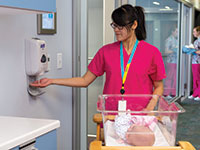
Instant insight
Hand-hygiene events are automatically recorded when the caregiver uses the dispenser.Stanley Healthcare
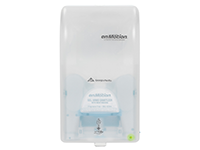
In and out
The SafeHaven system measures hand-hygiene compliance upon entry and exit in real time. Georgia Pacific LLC
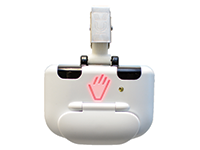
Being transparent
This badge communicates hand-hygiene compliance status directly to patients, family members and coworkers by way of green, yellow and red indicator lights.Biovigil Hygiene Technologies LLC
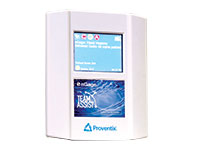
Flexible data
nGage system captures, stores and aggregates data for use with a variety of data management tools.Proventix Systems Inc.
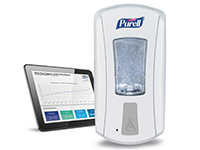
Full support
SMARTLINK hand-hygiene solution combines electronic compliance monitoring with hand-hygiene products, dispensing systems and clinician-based support.GOJO Industries
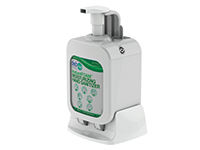
High-five
This system provides accurate compliance rates based on the World Health Organization’s 5 Moments for Hand Hygiene Compliance.DebMed
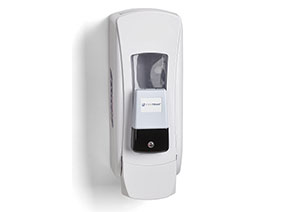
Tailored Solution
This system can be deployed on a standalone basis or in conjunction with the company's RTLS functionality.CenTrak



